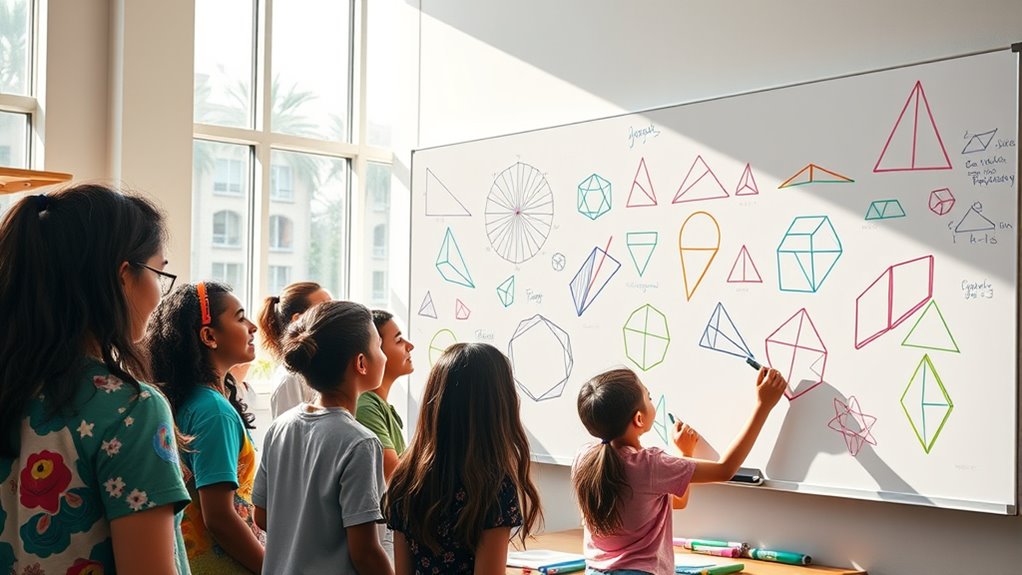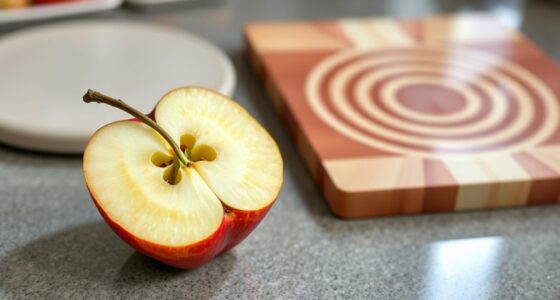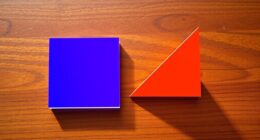We want to hear from you! Your opinion guides us to choose exciting and relevant geometry topics. Whether you’re curious about transformations, proofs, non-Euclidean geometries, or the beauty of fractals, your voice matters. Share your preferences and help shape our future lessons. By contributing, you’ll discover how these concepts connect to real-world applications and natural patterns. Keep exploring, and you’ll learn even more about the fascinating world of geometry.
Key Takeaways
- Your feedback helps select engaging topics like transformations, proofs, or fractals for future geometry content.
- Voting ensures the curriculum reflects student interests and enhances understanding of symmetry, visualization, or non-Euclidean geometries.
- Contributing your preferences supports developing materials that improve spatial reasoning and geometric problem-solving skills.
- Participating in the vote guides the focus on practical applications, historical insights, or advanced concepts in geometry.
- Your input shapes educational resources that foster creativity, visualization, and deeper comprehension of geometric principles.
Exploring Transformations: Rotations, Reflections, and Translations
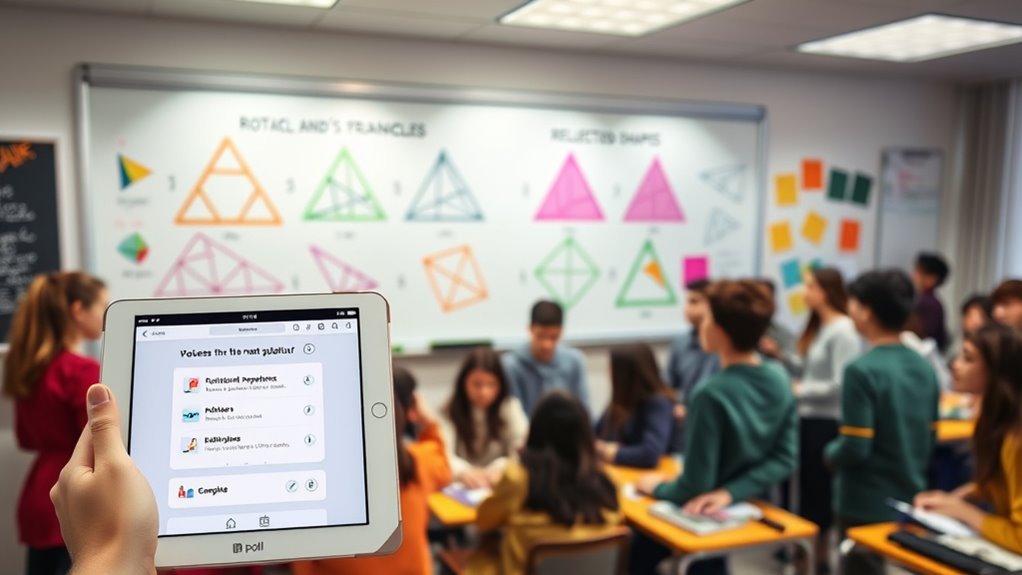
Transformations are fundamental in understanding how shapes move and change on the plane. When exploring rotations, reflections, and translations, you’ll see how shapes relate to coordinate planes. Rotations turn a shape around a point, often the origin, creating a new position while maintaining size and shape. Reflections flip a shape across a symmetry axis, which acts as a mirror line, producing a mirror image. Translations slide shapes along the coordinate plane without altering their size or orientation. Recognizing symmetry axes helps you understand how shapes can be reflected or rotated to match their original form. These transformations reveal the underlying structure of geometric figures and how they relate to their positions on the plane. They are essential tools in visualizing and analyzing geometric relationships. Understanding symmetry enhances your ability to identify how shapes can be manipulated through these transformations.
Unlocking the Secrets of Geometric Proofs

Understanding the logic behind proofs helps you see how geometric ideas connect. Learning common proof techniques makes solving and constructing proofs easier. Visualizing geometric concepts can clarify complex relationships and strengthen your reasoning skills. Incorporating mindfulness practices into your study routine can improve concentration and reduce mental clutter, making learning more effective.
Logic Behind Proofs
To truly grasp geometric proofs, you need to understand the logic that underpins them. Logical deduction is the foundation that guides your reasoning, helping you connect statements and draw valid conclusions. Proof strategies involve carefully choosing the most effective way to demonstrate a statement, whether through direct proof, contradiction, or contrapositive. By mastering these strategies, you ensure your arguments are clear and convincing. Recognizing how each step logically follows the previous one is essential—you want your proof to be airtight. When you understand the logic behind proofs, you can approach complex problems with confidence, knowing how to construct a solid argument from given information. This understanding transforms abstract concepts into a systematic process you can confidently apply. Additionally, understanding performance cookies can help you analyze how your proofs are received by others, improving your presentation skills.
Common Proof Techniques
Mastering geometric proofs often involves applying specific techniques that make your arguments clearer and more convincing. One common method is proof by contradiction, where you assume the opposite of what you’re trying to prove and show it leads to a contradiction. This technique effectively confirms the original statement. Another powerful tool is coordinate geometry, which allows you to translate geometric problems into algebraic equations using coordinates. By assigning points to a coordinate plane, you can analyze distances, slopes, and angles with algebra, simplifying complex proofs. These techniques help you approach proofs systematically, giving you clarity and confidence. Using proof by contradiction and coordinate geometry together can often solve problems that are difficult to tackle with purely synthetic methods.
Visualizing Geometric Ideas
Have you ever wondered how visualizing geometric ideas can make proofs easier to understand? When you picture shapes like triangular prisms or plot points on coordinate planes, you gain a clearer perspective of spatial relationships. Visualizing these ideas helps you see congruences, similarities, and intersections more intuitively. For example, imagining a triangular prism’s faces and edges in 3D clarifies how its volume and surface area relate. Similarly, working with coordinate planes lets you translate algebraic equations into visual forms, revealing patterns and symmetries. This approach simplifies complex proofs by making abstract concepts concrete. Additionally, understanding how to visualize geometric relationships enhances your overall comprehension and problem-solving skills. By developing your ability to visualize geometric ideas, you uncover a powerful tool that enhances your understanding and makes geometric proofs more accessible and engaging.
Diving Into Non-Euclidean Geometries

Ever wondered how geometry changes when you step outside the familiar rules of Euclidean space? Non-Euclidean geometries explore this, revealing new worlds like hyperbolic planes, where the usual rules don’t apply. These geometries use non Euclidean metrics, altering concepts like parallel lines and angles. In hyperbolic space, lines diverge, and triangles have angles summing to less than 180°. Understanding these ideas broadens your perspective on space and shape. Here’s a simple visual to clarify these differences:
| Feature | Euclidean Geometry | Hyperbolic Geometry | Spherical Geometry |
|---|---|---|---|
| Parallel Lines | Stay parallel | Diverge | Converge |
| Triangle Angle Sum | 180° | Less than 180° | More than 180° |
| Curvature | Flat | Negative | Positive |
| Lines | Straight | Curved in hyperbolic | Great circles |
| Space Type | Euclidean | Hyperbolic | Spherical |
Explore these ideas and see how geometry transforms beyond Euclidean limits. Additionally, understanding the non Euclidean metrics used in these geometries helps you appreciate how space can be curved in different ways.
The Fascinating World of Fractals and Self-Similarity

You’ll find that fractals reveal infinite patterns that repeat at different scales, creating mesmerizing designs. These self-similar structures appear all around us, from coastlines to snowflakes. Exploring these forms shows how nature’s fractal patterns shape the world in surprising ways. Understanding self-similarity is key to recognizing the underlying order in complex natural patterns.
Infinite Patterns Unveiled
What makes fractals so mesmerizing is their infinite complexity hidden within simple rules. These patterns reveal an endless variety of shapes and structures, repeating at every scale. You’ll see how infinite patterns emerge naturally from basic formulas, creating stunning visual effects. Geometric tessellations, for instance, demonstrate how shapes can fit together without gaps or overlaps, forming intricate, repeating designs. These tessellations are just one example of how simple rules produce complex arrangements. Fractals showcase self-similarity, where each part mirrors the whole, revealing the beauty of mathematical repetition. By exploring these concepts, you gain insight into the fundamental patterns that shape both abstract mathematics and the natural world. self-similarity is a key property that explains how detailed structures recur at different levels of scale, enriching our understanding of geometric patterns. It’s a fascinating journey into the endless creativity within geometry’s simplest building blocks.
Nature’s Fractal Forms
Have you ever noticed how the branching patterns of trees or the spirals of seashells mirror each other across different natural objects? These are examples of fractal forms, showcasing self-similarity and natural symmetry. Fractal landscapes reveal complex patterns that repeat at different scales, creating breathtaking visuals in nature. You can find fractals in coastlines, mountain ranges, and cloud formations. Understanding these natural structures helps you appreciate the universe’s intricate design. Here’s a quick look at fractal patterns:
| Feature | Example | Significance |
|---|---|---|
| Self-similarity | Fern leaves | Reveals recursive design |
| Natural symmetry | Snowflakes | Shows perfect balance |
| Fractal landscapes | Mountain ranges | Creates diverse terrains |
These patterns demonstrate nature’s incredible complexity and beauty. Recognizing fractal patterns enhances our understanding of the interconnectedness within natural systems.
Applications of Geometry in Real Life
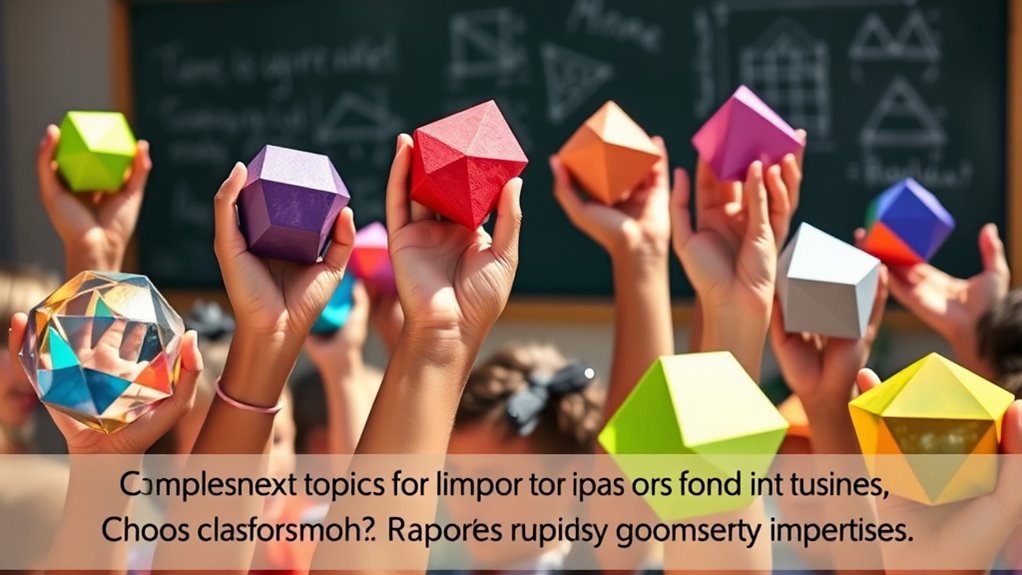
Ever wondered how geometry shapes the world around us? It’s everywhere, from architectural design to sports strategy. Architects use geometric principles to create stable, beautiful structures that optimize space and strength. In sports, players and coaches rely on geometry to improve positioning, angles, and trajectories, giving teams a competitive edge. Geometry also helps in designing efficient transportation routes, optimizing packaging, and even in medical imaging. Whether you realize it or not, understanding geometric concepts enhances everyday decisions and innovations. By applying geometry, professionals solve real-world problems with precision and creativity. It’s a crucial tool that influences how we build, move, and improve our environment. Additionally, precise measurements derived from geometric calculations ensure accuracy in various engineering applications. Your awareness of these applications deepens appreciation for how math seamlessly integrates into daily life.
The History and Evolution of Geometric Concepts

The development of geometric concepts has a rich history that spans thousands of years. Early civilizations used geometric symbolism to represent their beliefs and ideas, often inscribing them in artifacts and monuments. Historical diagrams reveal how ancient cultures, like the Egyptians and Greeks, visualized complex ideas through diagrams and sketches. These diagrams helped communicate principles of symmetry, proportion, and harmony that still influence geometry today. Over time, thinkers such as Euclid formalized geometry into a systematic study, building on previous knowledge. The use of visual representations played a crucial role in conveying complex geometric ideas across different eras. As you explore this history, you’ll see how geometric ideas evolved from intuitive sketches to rigorous proofs, shaping not only mathematics but also art, architecture, and science. This evolution reflects humanity’s ongoing quest to understand and represent the world around us.
Hands-On Activities to Master Geometric Principles
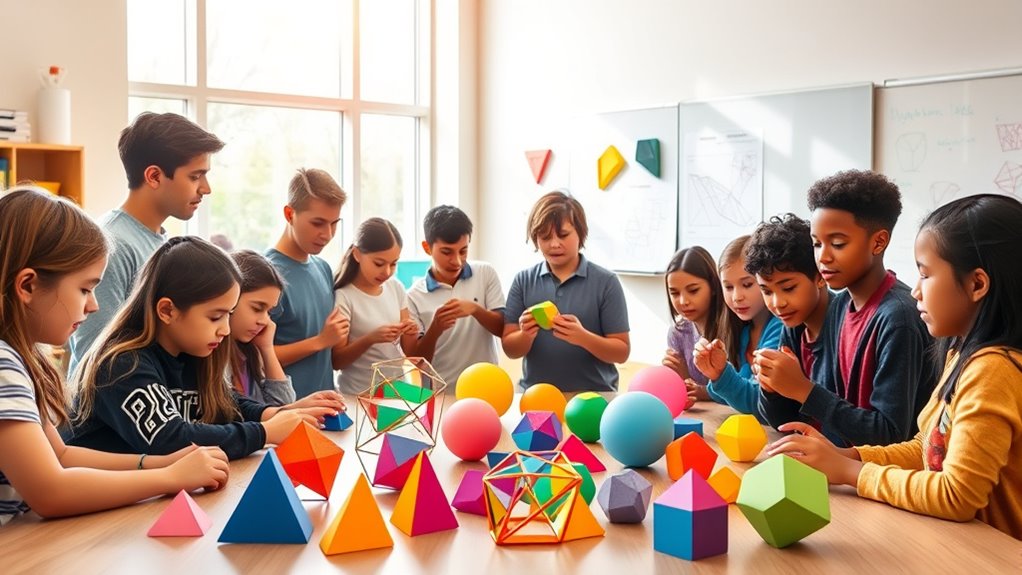
Want to deepen your understanding of geometric principles? Hands-on activities make learning engaging and effective. For example, you can draw angle bisectors using paper and a compass to see how they divide angles equally, reinforcing your grasp of this concept. You might also explore coordinate geometry by plotting points and lines on graph paper, then calculating distances and midpoints to understand the relationships between points. Building geometric models with physical objects helps visualize properties like congruence and similarity. These activities make abstract ideas tangible, improving retention. By actively experimenting with angle bisectors and coordinate geometry, you develop intuition and skills that formulas and diagrams alone can’t provide. Engaging directly with geometric principles makes your learning both fun and meaningful. Personal development techniques such as mindfulness and goal setting can further enhance your concentration and motivation during these activities.
Frequently Asked Questions
How Can I Make Learning Geometry More Engaging for Students?
To make learning geometry more engaging, you should incorporate interactive activities that involve hands-on experiences. Use real-world applications to show students how geometry is relevant to everyday life, like designing buildings or analyzing sports strategies. Encourage student participation through group projects or technology tools that allow exploration. This approach keeps students motivated, helps them understand concepts deeply, and makes learning geometry both fun and meaningful.
What Are Emerging Trends in Geometric Research and Applications?
Imagine exploring a universe where fractals reveal endless complexity, like a never-ending mosaic. Emerging trends in geometric research focus on fractals’ complexity and topology innovations, transforming how we comprehend shapes and spaces. These breakthroughs impact fields like computer graphics, data analysis, and material science. You can be part of this evolution, helping shape future discoveries and applications by staying informed and engaged with the latest geometric advancements.
How Do Cultural Differences Influence the Teaching of Geometry?
Cultural perspectives greatly influence how you teach geometry, shaping your approach to teaching diversity. You adapt your methods to respect different cultural backgrounds, making lessons more inclusive and engaging. By understanding diverse traditions and ways of thinking, you can create a richer learning environment. This awareness helps you address varied learning styles, ensuring all students feel valued and supported in their geometric understanding.
What Tools or Software Are Best for Exploring Advanced Geometric Concepts?
Perfectly powerful programs promote precise pondering of complex concepts. When exploring advanced geometric ideas, you should compare software options like GeoGebra, Cabri Geometry, and Desmos. These tools excel at geometric visualization, allowing you to manipulate and understand intricate shapes and theorems. By conducting a thorough software comparison, you’ll find the best fit for your needs, making complex concepts clearer and more accessible.
How Can Geometry Be Integrated Into Other STEM Subjects Effectively?
You can effectively integrate geometry into other STEM subjects by emphasizing spatial reasoning and real-world applications. Show how geometric concepts underpin engineering designs, biological structures, or computer graphics. Use hands-on activities, models, or software to help students visualize complex ideas. Connecting geometry to everyday technology and nature enhances understanding and engagement, making it clear how geometric principles are essential across various STEM fields.
Conclusion
Now it’s your turn to shape the future of geometry topics! Don’t worry if some ideas seem complex—they’re all part of the learning journey. Your voice matters, and by voting, you help make these fascinating concepts accessible and exciting for everyone. So go ahead, choose the topics that inspire you most. Together, we can explore the world of geometry and reveal its secrets—one idea at a time.
